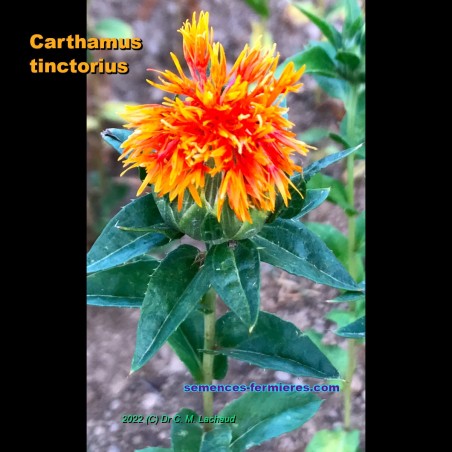








Carthamus tinctorius - Safflower
1 packet of 50 seeds
-
Carthamus tinctorius is a small annual herbaceous thistle, native to arid regions of North Africa
The leaves of Safflower are leathery and prickly, dark green, carried along a short stem which branches in its upper part
The stem is anchored in the ground by a tap root which can be very deep
In summer, honey-producing yellow inflorescences appear, which, as they age, turn orange and then turn orange-red
It is these mature Safflower ligules that are harvested and dried to serve as a source of bright red and pink dye (Carthamine)
The dye color of False Saffron is magnificent and very famous in certain countries like Japan
Unfortunately, it is moderately fast
30 to 45 days after flowering, Carthamus tinctorius produces seeds (Achenes) which can then be harvested
They look like small sunflower seeds (distant cousin of Safflower)
They contain a useful oil (safflower oil), rich in antioxidants, with restructuring, moisturizing and repairing properties for the skin (light and penetrating oil: Nourishing, emollient, softening, healing, and antifungal)
Safflower is cultivated on an industrial scale in Mexico, India, the USA, etc. for the production of Safflower seeds and oil
-
| Jan | Feb | Mar | Apr | May | Jun | Jul | Aug | Sep | Oct | Nov | Dec | ||
|---|---|---|---|---|---|---|---|---|---|---|---|---|---|
Sow the seeds in spring as soon as the soil temperature exceeds 6°C, in very sunny exposure (intolerant to shade), after the last risk of frost
Any type of soil is suitable as long as it is well-draining and dries quickly
The seeds are buried 2 cm deep, arranged in rows spaced 20 cm apart, at a density of 20 kg / ha
Safflower will grow vertically in order to flower during the summer
| Jan | Feb | Mar | Apr | May | Jun | Jul | Aug | Sep | Oct | Nov | Dec | ||
|---|---|---|---|---|---|---|---|---|---|---|---|---|---|
Sow the seeds at the end of summer as soon as the first rains begin, under the same conditions described in the previous section (only in regions with a mild climate where frosts remain light - Safflower can withstand negative temperatures down to -5°C when it is in the rosette stage and in dry climatic conditions)
When grown as a winter annual, Safflower establishes a rosette of leaves and grows slowly throughout the winter
It will have vertical growth for summer flowering in the following spring
This method of cultivation is preferable when possible, because the plant establishes a deep tap root which gives it greater vegetative power the following spring, resulting in higher productivity
____________________________
After germination, Safflower doesn't appreciate humidity because it is adapted to dry and hot climates (withstands 40°C)
The consequence of rain is that the plants often get attacked by fungal diseases, generally on the root system (Alternaria, Botrytis, Fusarium, Phytophthora, Pythium, Rhizoctonia, Sclerotinia, and Verticillum)
This will occur in spring if the sowing is done too early, and in autumn if the plants are still in the maturation phase of their seeds
Outside the Mediterranean regions, it is therefore better to sow Safflower at the beginning of June for a flowering in August - particularly if the aim is to harvest the ligules for natural dyeing
To get seeds, count on a short crop cycle (annual spring) - 4 months (seeds mature in 1 month after the end of flowering)
Weed regularly regardless of the cultivation method: Safflower is a small, not very stifling plant which, without this precaution, will quickly be overwhelmed by weeds
You might also like
Payment :
PayPal < 150 €
Check < 850 €
Bank Wire > 149 €
Thank you for your kind understanding